Single Photon Emission Computed Tomography Market Size and Trends
Global single photon emission computed tomography market is estimated to be valued at USD 3.34 Bn in 2025 and is expected to reach USD 5.26 Bn by 2032, growing at a compound annual growth rate (CAGR) of 6.7% from 2025 to 2032.
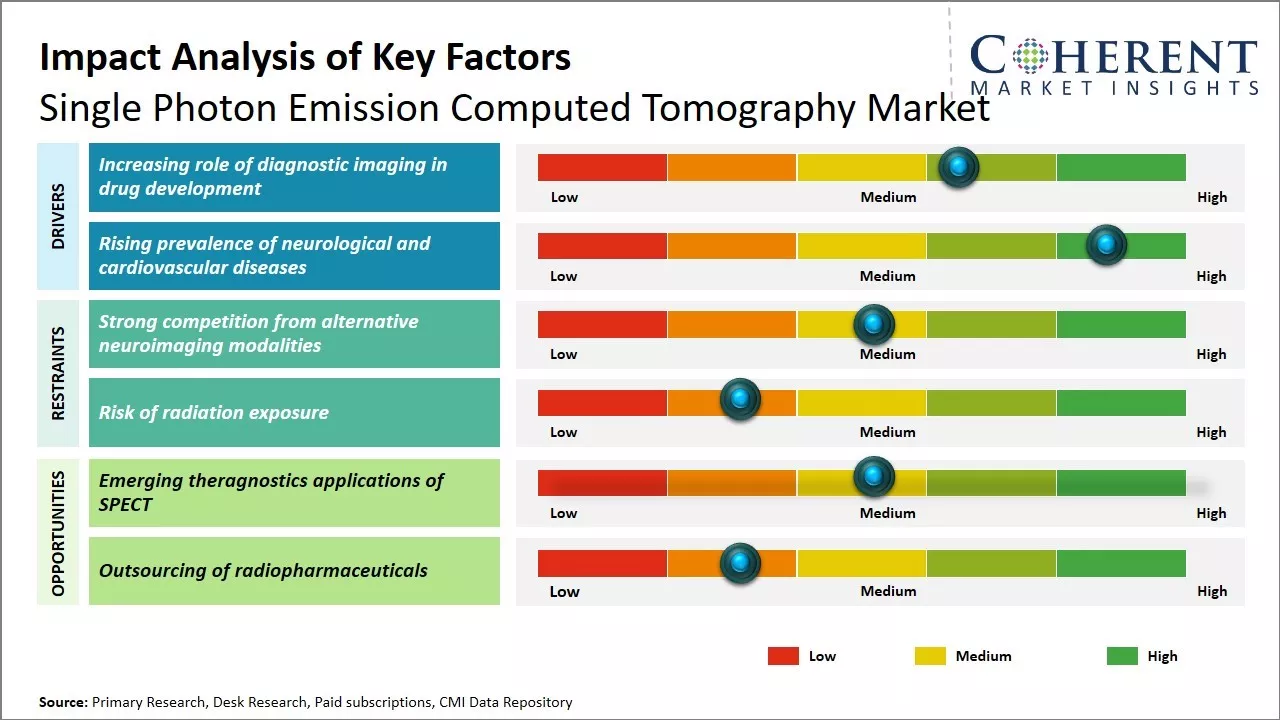
Discover market dynamics shaping the industry: Download Free Sample
The single photon emission computed tomography market is anticipated to demonstrate positive growth trajectory during the forecast period. Factors such as favorable reimbursement policies, technological advancements for better image quality and shorter scan time, increasing public-private investments for medical equipment and facilities, growing awareness about early disease diagnosis are expected to boost demand for SPECT devices. However, higher cost of equipment and procedure in comparison to other modalities and better accuracy of hybrid PET may restrain the market growth.
Increasing Role of Diagnostic Imaging in Drug Development
Global single photon emission computed tomography market is expected to grow significantly owing to increasing role of diagnostic imaging modalities such as SPECT in drug development and research activities. Pharmaceutical companies are exploring various imaging techniques to gain deeper insights into drug mechanisms and their effects on the human body. SPECT provides detailed functional information regarding drug distribution and target engagement in vivo, which helps researchers evaluate drug candidates at a very early stage. This early assessment allows them to eliminate non-viable compounds from the pipeline and focus resources on molecules with the highest chances of success. Researchers are able to see whether the drug reaches its intended target and verify, if engagement results in the desired downstream effects. Any safety issues can be identified early. Such quantitative and qualitative data obtained from SPECT and other molecular imaging techniques enables go/no-go decisions much before entering costly and time-consuming clinical trials. This greatly improves productivity in drug development by minimizing failures in late stages. Pharmaceutical companies are increasingly relying on molecular imaging to the risk candidates and extract maximum information from limited preclinical studies.
Market Concentration and Competitive Landscape
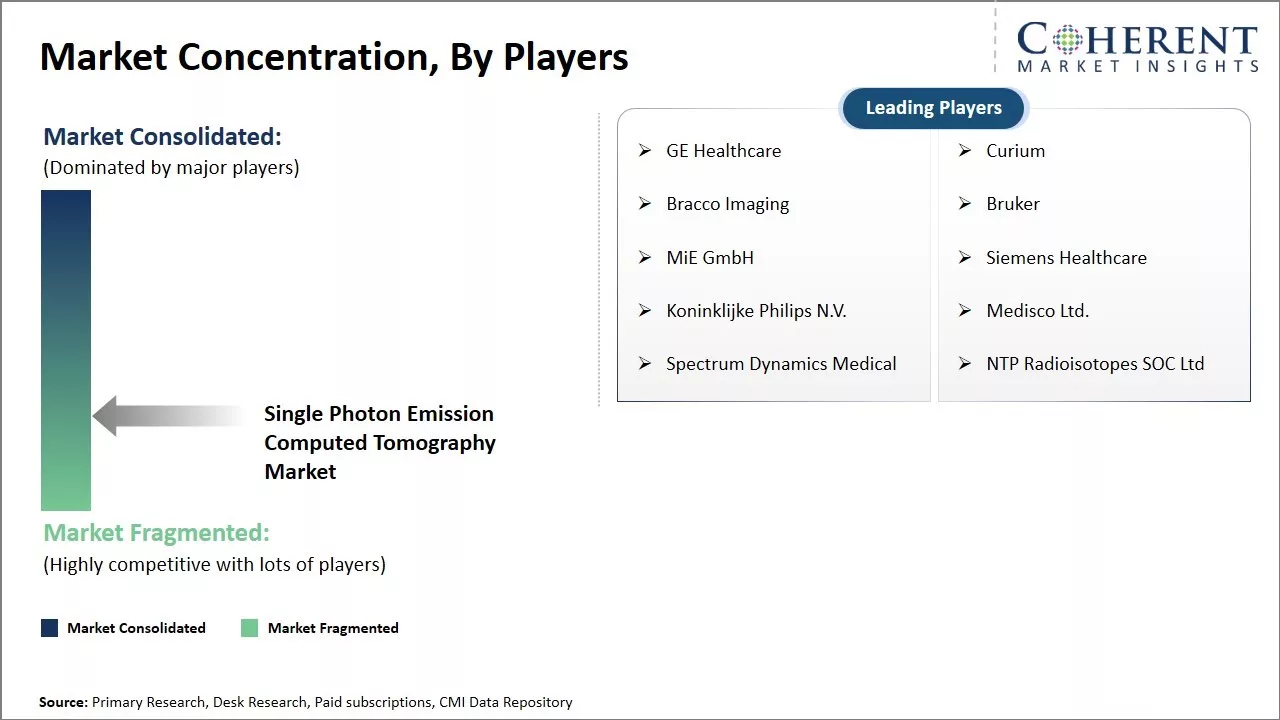
Get actionable strategies to beat competition: Download Free Sample
Rising Prevalence of Neurological and Cardiovascular DiseasesThe growth in neurological disorders and cardiovascular diseases worldwide has translated to higher demand for diagnostic procedures that can accurately detect the presence and extent of such conditions. SPECT provides detailed functional information about perfusion and metabolic activity within brain and heart tissues, which is invaluable for differential diagnosis and treatment management of various neurological and cardiac pathologies. It allows visualization of subtle changes not seen on conventional imaging like CT or MRI, thereby facilitating early and more effective clinical intervention. Diseases like Alzheimer's and dementia are rising rapidly as the geriatric population expands globally. Brain SPECT scans can identify signs of neurodegeneration years before symptoms appear by tracking declines in regional cerebral blood flow patterns. In cardiology, SPECT myeloscintigraphy evaluate ischemic areas within the heart muscle in conditions like Coronary Artery Disease. It also aids in diagnosis of less common cardiac involvements like sarcoidosis, amyloidosis and cardiomyopathy. Given the growing burden of these diseases, healthcare providers are relying more on functional imaging modalities like SPECT to improve diagnostic accuracy and optimize care.
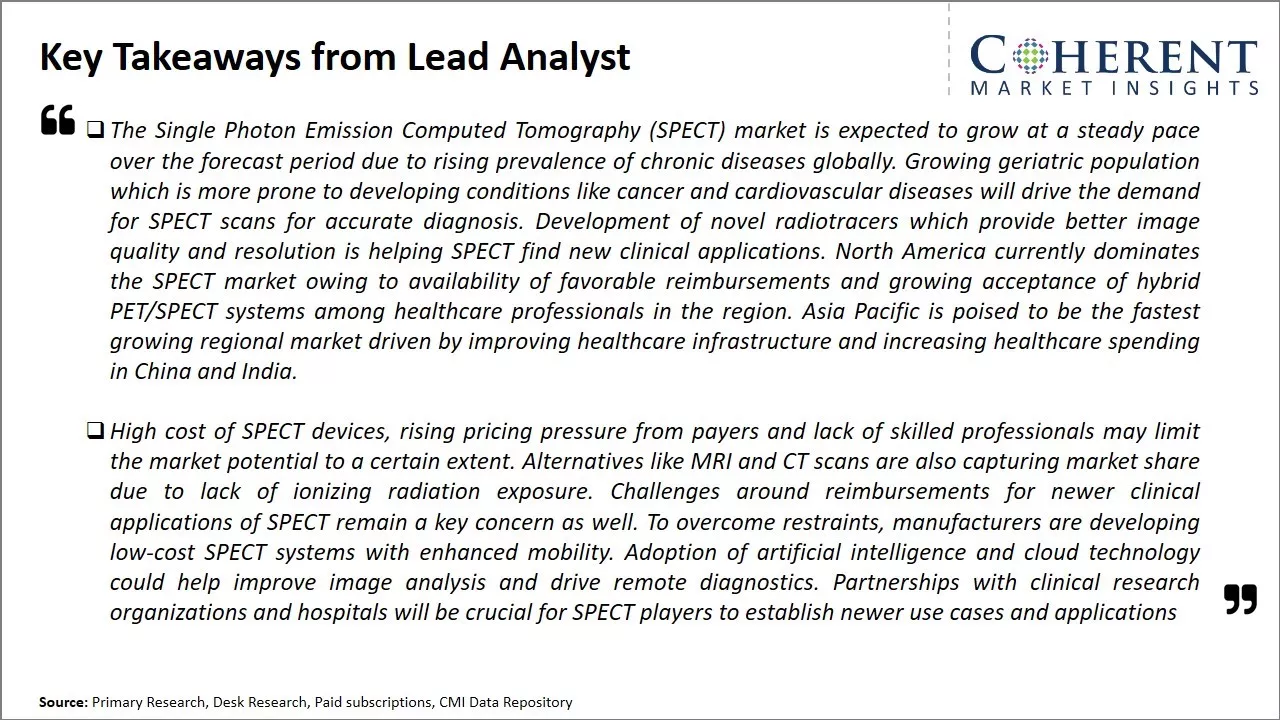
To learn more about this report, Download Free Sample
Market Challenges – Strong competition from alternative neuroimaging modalitiesGlobal single photon emission computed tomography market faces several challenges. There is strong competition from alternative neuroimaging modalities like MRI and CT scans that provide higher resolution images. The use of radiotracers also raises regulatory compliance issues. SPECT scans have lower sensitivity and need longer scanning times compared to PET. The high equipment and operational costs pose significant barriers, especially in price-sensitive developing markets.
Market Opportunities - Emerging Theragnostics applications of SPECT
Emerging theragnostic applications of SPECT could provide a significant opportunity for growth of global single photon emission computed tomography (SPECT) market. Theragnostics involves combining targeted cancer therapeutics with diagnostic imaging techniques. With SPECT's ability to provide molecular imaging data, it is uniquely positioned to advance theragnostic applications and personalize treatment plans for patients. SPECT can monitor drug delivery and response in real-time, evaluating aspects like bio distribution, pharmacokinetics and target engagement of novel radiolabeled therapeutics. For example, SPECT tracers are being studied alongside immune cell therapies to track immune cells after infusion and predict likelihood of response. By assessing the distribution and movement of cell therapies or targeted drugs throughout the body at a molecular level, SPECT can guide therapy adjustments on an individual basis. This precision approach aims to maximize outcomes while minimizing toxicity - an important goal given rising drug costs.
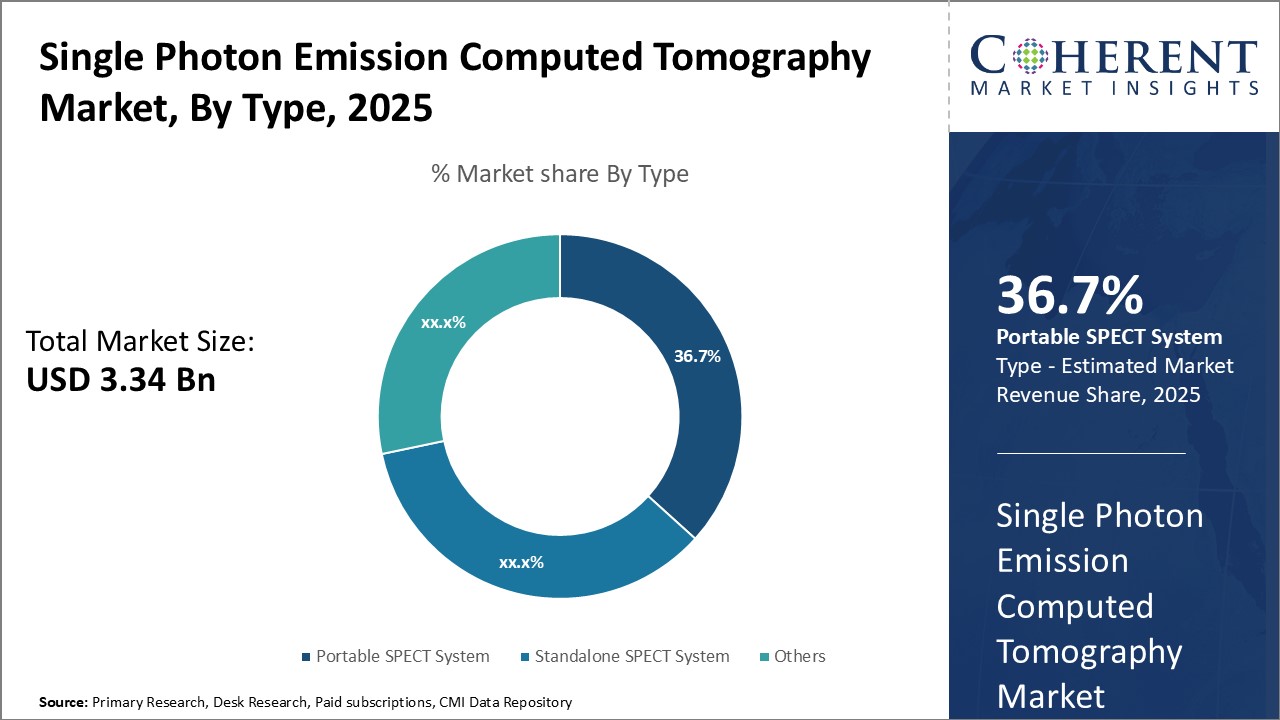
Discover high revenue pocket segments and roadmap to it: Download Free Sample
Insights, By Type: Optimizes SPECT WorkflowThe type segment includes Portable SPECT System, Standalone SPECT System, and Others. In terms of type, Portable SPECT System segment is estimated to hold 36.7% market share in 2025, owing to its unmatched portability. Unlike fixed SPECT systems, portable SPECT scanners can be easily moved between examination rooms which optimizes workflow efficiency. Their compact designs allow them to fit into tight spaces for point-of-care imaging, right beside patients. This eliminates the need for patient transportation and reduces delays in diagnosis and treatment. The true portability of these systems gives healthcare providers maximum flexibility to image patients anywhere, even outside of nuclear medicine departments and hospitals. Their lightweight and wireless capabilities make portable SPECT ideal for mobile clinics and tertiary care centers with limited floor space. The seamless transportability allows SPECT exams to be scheduled back-to-back without interruptions, improving throughput.
Insights, By Type of Radioisotopes: Versatility of Radioisotopes
The type of radioisotopes segment includes Tc-99m, Ra-223, Ga-67, I-123, Th-201, and others. In terms of type of radioisotopes, Ga-67 contributes the 37.8% market share in 2025 owing to its unique advantages over other radioisotopes. Ga-67 demonstrates high versatility for imaging various clinical indications due to its ability to localize in infection, inflammation and tumors. It exhibits favorable emission characteristics and tissue kinetics that provide diagnostic images with good target-to-background ratios. The 3-day half-life of Ga-67 makes it convenient for imaging processes without requiring expensive infrastructure for isotope handling. Its gamma photon emissions are well-suited for SPECT imaging hardware. Most importantly, Ga-67 citrate demonstrates excellent safety profile and defined dosage guidelines facilitating its widespread clinical adoption.
Insights, By Application: Increasing Prevalence of Cancer
The application segment includes cardiology, oncology, neurology, and others. In terms of application, oncology contributes 46.2% share in 2025, owing to the critical role of SPECT in cancer diagnostics and management. SPECT has proven effective in tumor staging, restaging and treatment response monitoring in various malignancies. Its quantitative whole-body functional imaging provides insights into metabolic activity, cellular proliferation and receptor expression on cancer cells. These molecular characteristics aid in diagnosis, differential diagnosis, treatment planning and follow-up. SPECT tracers like FDG, MIBG and SSTR-targeted agents offer high sensitivity and specificity for detecting tumors, their spread and recurrence. This makes SPECT indispensable in oncology for guiding personalized care pathways and long-term surveillance of cancer patients.
Regional Insights
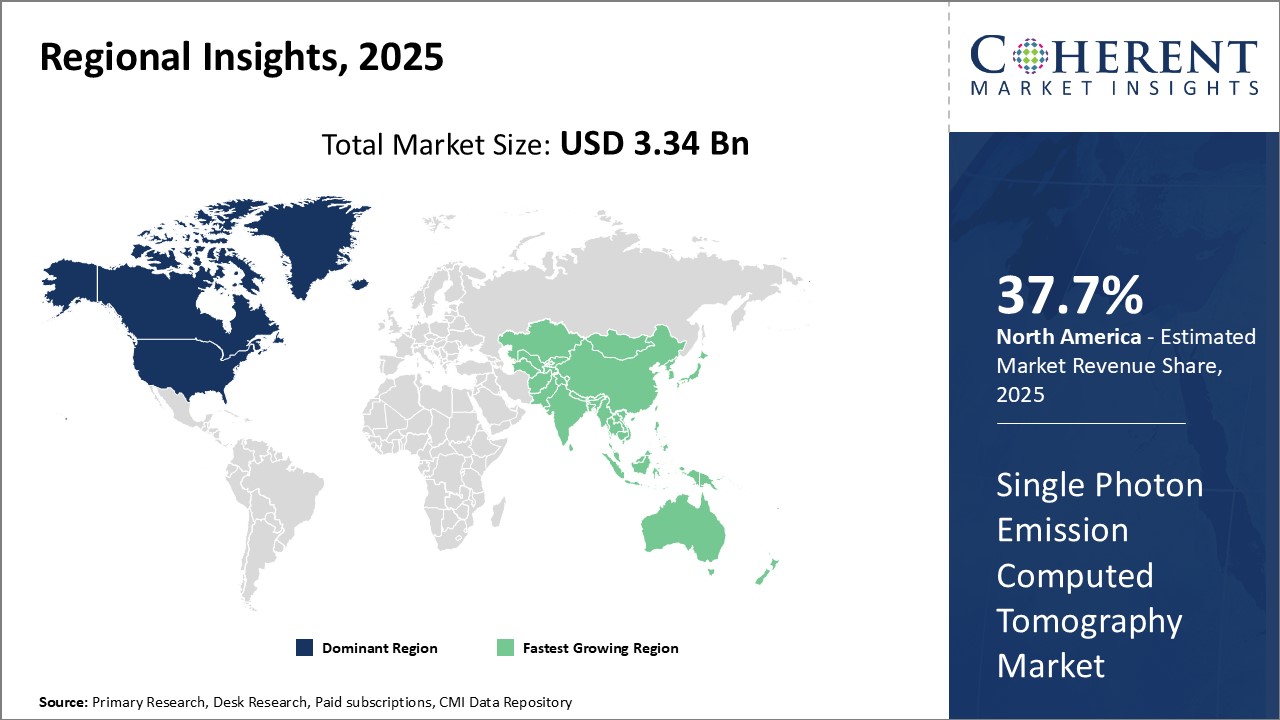
Need a Different Region or Segment? Download Free Sample
North America has established itself as the dominant player in the global single photon emission computed tomography market with 37.7% market share in 2025. The region boasts of a highly developed healthcare infrastructure and strong presence of major SPECT manufacturers. The U.S. accounts for the largest share of the market owing to an increasing patient base, favorable reimbursement policies and growing awareness among physicians regarding diagnostic imaging. The non-invasive SPECT procedures are widely adopted across various clinical settings in the region including cardiology, neurology and oncology. Moreover, technical advancements such as introduction of SPECT-CT systems have further boosted the demand for single emission computed tomography. Multiple diagnostics laboratories are well-equipped with state-of-the-art SPECT systems to cater to the needs of large patient pool suffering from chronic diseases. This has significantly contributed to the North American market remaining at the forefront.
Asia Pacific region stands out as the second fastest growing region and holds 27.5% market share in 2025, due to rapid economic development and improving access to advanced healthcare facilities have played a pivotal role. Countries like China, India, South Korea and Japan are at the cusp of adopting world-class clinical standards. Growing healthcare expenditures and rising per capita income have enabled more patients to opt for SPECT scans. Government initiatives to strengthen medical infrastructure across emerging Asian nations will further propel the demand for computed tomography. Favorable FDI policies have encouraged renowned SPECT giants to increasingly extend their reach through manufacturing and distribution agreements. Increasing trade relationships have enabled wider availability of imported systems at competitive rates. This has positively impacted SPECT penetration even in remote parts of Asia Pacific region.
Market Report Scope
Single Photon Emission Computed Tomography Market Report Coverage
| Report Coverage | Details | ||
|---|---|---|---|
| Base Year: | 2024 | Market Size in 2025: | USD 3.34 Bn |
| Historical Data for: | 2020 To 2024 | Forecast Period: | 2025 To 2032 |
| Forecast Period 2025 to 2032 CAGR: | 6.7% | 2032 Value Projection: | USD 5.26 Bn |
| Geographies covered: |
|
||
| Segments covered: |
|
||
| Companies covered: |
GE Healthcare, Curium, Bracco Imaging, Bruker, MiE GmbH, Siemens Healthcare, Koninklijke Philips N.V., Medisco Ltd., Spectrum Dynamics Medical, NTP Radioisotopes SOC Ltd |
||
| Growth Drivers: |
|
||
| Restraints & Challenges: |
|
||
Uncover macros and micros vetted on 75+ parameters: Get instant access to report
Single Photon Emission Computed Tomography Industry News
- In October 2022, Spectrum Dynamics, a medical technology company, announced its recent development in digital nuclear medicine imaging. New VERITON-CT-400 Series Digital SPECT/CT scanners are capable of imaging high-energy isotopes using solid state detector technology with wide-bore configuration.
- In June 2022, Siemens Healthineers, a leading company in SPECT market, announced that the company had received approval from the U.S. Food & Drug Administration (FDA) for new SPECT/CT scanner ‘Symbia Pro. Specta SPECT/CT scanner. This new SPECT/CT scanner offers a variety of enhanced capabilities including low dose CT up to 64 slices.
- In May 2022, Swansea’s Singleton Hospital, a global leader in the diagnosis of cancer and other serious conditions, received US$ 5.2 million state-of-the-art scanners investment. This investment will be utilized to purchase new SPECT/CT equipment that will help clinicians to spot cancer at early stage.
*Definition: A single photon emission computed tomography (SPECT) scan is an imaging test that shows how blood flows to tissues and organs. It may be used to help diagnose seizures, stroke, stress fractures, infections, and tumors in the spine.
Market Segmentation
- Type Insights (Revenue, USD BN, 2020 - 2032)
- Portable SPECT System
- Standalone SPECT System
- Others
- Type Of Radioisotopes Insights (Revenue, USD BN, 2020 - 2032)
- Tc-99m
- Ra-223
- Ga-67
- I-123
- Th-201
- Others
- Application Insights (Revenue, USD BN, 2020 - 2032)
- Cardiology
- Oncology
- Neurology
- Others
- End User Insights (Revenue, USD BN, 2020 - 2032)
- Hospitals
- Diagnostic Imaging Centers
- Ambulatory Surgical centers
- Others
- Regional Insights (Revenue, USD BN, 2020 - 2032)
- North America
- U.S.
- Canada
- Latin America
- Brazil
- Argentina
- Mexico
- Rest of Latin America
- Europe
- Germany
- U.K.
- Spain
- France
- Italy
- Russia
- Rest of Europe
- Asia Pacific
- China
- India
- Japan
- Australia
- South Korea
- ASEAN
- Rest of Asia Pacific
- Middle East
- GCC Countries
- Israel
- Rest of Middle East
- Africa
- South Africa
- North Africa
- Central Africa
- North America
- Key Players Insights
- GE Healthcare
- Curium
- Bracco Imaging
- Bruker
- MiE GmbH
- Siemens Healthcare
- Koninklijke Philips N.V.
- Medisco Ltd.
- Spectrum Dynamics Medical
- NTP Radioisotopes SOC Ltd
Share
Share
About Author
Manisha Vibhute is a consultant with over 5 years of experience in market research and consulting. With a strong understanding of market dynamics, Manisha assists clients in developing effective market access strategies. She helps medical device companies navigate pricing, reimbursement, and regulatory pathways to ensure successful product launches.
Missing comfort of reading report in your local language? Find your preferred language :
Transform your Strategy with Exclusive Trending Reports :
Frequently Asked Questions
EXISTING CLIENTELE
Joining thousands of companies around the world committed to making the Excellent Business Solutions.
View All Our Clients
